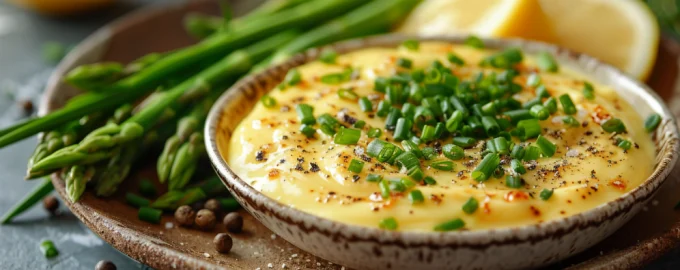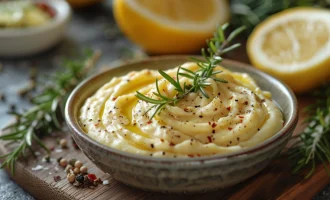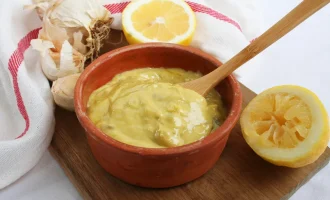Hollandaise sauce, a classic of French cuisine, is an emulsion of egg yolk, melted butter, and lemon juice or vinegar. It’s one of the five mother sauces in French cooking and is famed for its rich, buttery flavor and smooth, velvety texture. The origins of hollandaise sauce date back to the 17th century, with various regions in Europe, including Holland and France, claiming its invention. It has since become a staple in fine dining establishments and home kitchens alike, particularly as a key component of dishes like Eggs Benedict, asparagus, and seafood.
- Egg yolks 60 g
- Unsalted butter 200 g
- Lemon juice 15 ml
- Cold water 15 ml
- Salt a pinch
- Cayenne pepper or white pepper a pinch
- Fill a pot with a couple of inches of water and bring it to a simmer over low heat. Find a heatproof bowl that can sit on top of the pot without touching the water. The steam from the water will gently cook the sauce.
- In the heatproof bowl, whisk together the egg yolks and cold water until the mixture is light and frothy. This helps to stabilize the sauce and prevent the eggs from scrambling.
- Place the bowl over the simmering pot of water (double boiler). Continue to whisk vigorously and constantly. The mixture should start to thicken as it cooks. To prevent overheating, occasionally remove the bowl from the pot while continuing to whisk, then return it to the heat.
- Once the egg mixture has thickened and doubled in volume, begin to add the melted butter slowly, whisking continuously. Start with a few drops at a time, then proceed to a thin stream until all the butter is incorporated. This gradual process helps to create a stable emulsion.
- Remove the bowl from the heat. Stir in the lemon juice, salt, and a pinch of cayenne or white pepper. Adjust the seasoning to taste.
- Hollandaise sauce should be served warm. It’s not suitable for reheating, as it can easily split or curdle.
Storage Tips
Hollandaise sauce is best enjoyed fresh and does not store well due to its delicate nature. If absolutely necessary, it can be kept at room temperature for a short period (no more than an hour or two) before serving, but it should not be refrigerated or reheated.
Useful Properties of the Main Ingredient
Eggs, the base of hollandaise sauce, are highly nutritious, providing high-quality protein, vitamins (such as B2, B12, D, and E), minerals (including selenium and iodine), and antioxidants.
Interesting Facts
- Hollandaise sauce is traditionally made by hand with a whisk, but modern variations include using a blender to emulsify the sauce, making it more accessible for home cooks.
- The key to a successful hollandaise lies in the temperature control; too much heat can cause the sauce to split, while too little won’t allow it to thicken properly.
- Aside from its classic pairings, innovative chefs have used hollandaise as a base for other sauces, adding ingredients like tarragon for Bearnaise sauce or tomato for sauce Choron.
This classic hollandaise sauce recipe brings a touch of elegance to any dish, embodying the sophistication of French cuisine with its silky texture and balanced flavors.






